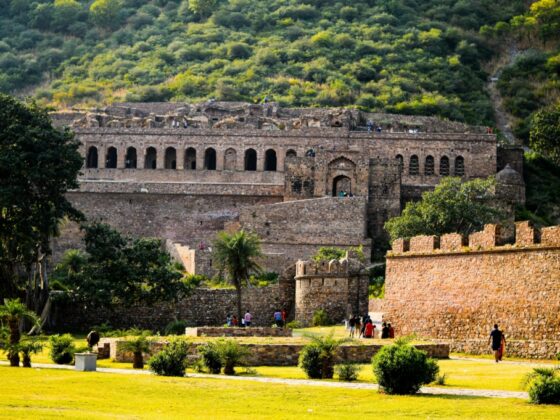The art of Poshak reflects Rajasthan’s royal heritage, showcasing exquisite fabrics, intricate embroidery, and vibrant colors. Worn by Rajput kings and queens, these traditional royal costumes symbolize status, culture, and identity. Even today, Rajasthani Poshak remains a significant part of weddings and festivals, preserving the grandeur of the past.

The Significance of Poshak in Rajasthani Culture
Rajasthan’s rulers and noble families carefully selected their attire to reflect their lineage, authority, and regal aesthetics. The Poshak, a traditional outfit worn by Rajput women, and the Angarkha, favored by Rajput men, represent elegance and pride.
Elements of Royal Rajasthani Attire
1. Rajput Women’s Poshak: A Blend of Grace and Grandeur
The Rajput Poshak consists of:
- Ghaghra (Skirt): Made from rich silk or cotton, adorned with gota patti, zardozi, and mirror work.
- Kanchli (Blouse): Fitted and embroidered, often featuring delicate handwork.
- Odhni (Veil/Dupatta): Draped elegantly over the head and shoulders, symbolizing modesty and respect.
Princesses and queens preferred fabrics like chiffon, silk, and georgette, dyed in vibrant hues of red, yellow, pink, and royal blue, signifying prosperity and tradition.
2. Rajput Men’s Attire: Strength and Prestige
The royal wardrobe of Rajput men included:
- Angarkha: A long, flared tunic with intricate embroidery.
- Churidar or Dhoti: Comfortable yet elegant lower garments.
- Pagri (Turban): A symbol of honor, with colors and styles varying by region and occasion.
- Kamarbandh and Patka: Waistbands and scarves worn as accessories to enhance the grandeur.
Rajput warriors often chose heavily embroidered angarkhas in deep hues like maroon, saffron, and green, reflecting courage and valor.
Fabrics and Embellishments: The Hallmark of Royal Poshak
The art of Poshak thrives on luxurious materials like silk, brocade, and velvet. Gota patti, zardozi, kundan, and mirror work elevate the attire, making it fit for royalty. Craftsmen spend weeks perfecting each piece, ensuring intricate patterns and flawless embroidery.
Modern Influence and Revival
Though modern fashion has evolved, Rajasthan’s traditional Poshak remains relevant. Brides and grooms often choose handcrafted Poshaks for weddings, while designers incorporate royal elements into contemporary styles. Celebrities and fashion enthusiasts worldwide appreciate the regal elegance of Rajasthani attire.
Conclusion
The art of Poshak continues to celebrate Rajasthan’s regal history, with its rich fabrics, vibrant colors, and exquisite embroidery. As a timeless expression of cultural identity, Rajasthani royal costumes remain a cherished legacy, blending tradition with modern aesthetics.


